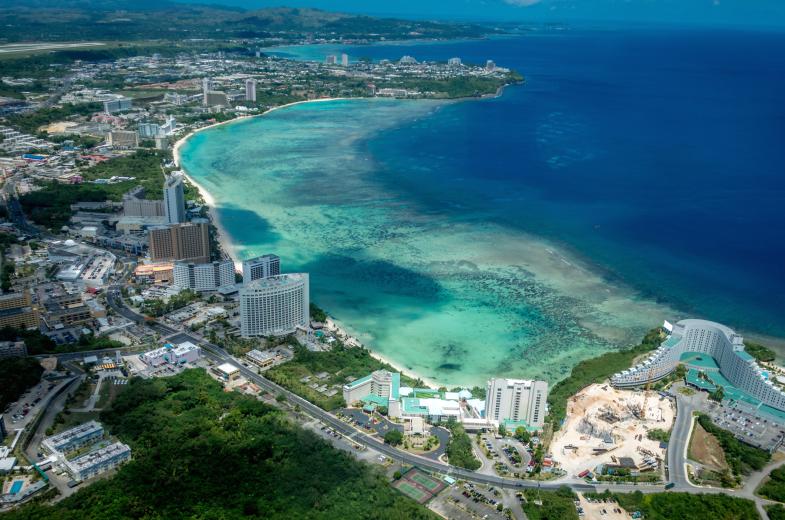Guam Visitors Bureau
- 401 Palé San Vitores Road, Tumon, GUAM, 96913
- Phone: (671) 646-5278
- Email: info@visitguam.com
about Guam Visitors Bureau
MISSION
The mission of the Guam Visitors Bureau is to efficiently and effectively promote and develop Guam as a safe and satisfying destination for visitors and to derive maximum benefits for the people of Guam.
HISTORY
Guam's development of tourism was first acknowledged by local government officials in 1952 with the enactment of Public Law 67. The law implemented a plan to establish a travel industry on Guam. The measure was passed by the First Guam Legislature and signed into law by then Governor Carlton Skinner.
Unfortunately, the territory was blanketed with a security restriction on travel imposed by the formal naval administration. It was not until 1962, when President John F. Kennedy lifted the security restriction, that Guam's tourism development would move closer to realization.
In 1963, the Government of Guam established the Guam Tourist Commission within the Department of Commerce via Executive Order 63-10, which was issued by then Governor Manuel F.L. Guerrero. With an initial budget of $15,000, the Guam Tourist Commission immediately began aggressive travel trade promotions in Japan and Southeast Asia. Additionally, the Commission worked diligently on the development of Guam's tourism plan and lobbied air carriers to increase flight service to Guam from potential market areas.
The rewards of the Commission's efforts were reaped four years later, when on May 1, 1967, Pan American World Airways landed on Guam with 109 Japanese tourists. In that first year, Guam recorded 6,600 visitor arrivals.
In July 1970, the Guam Tourist Commission was renamed Guam Visitors Bureau. Separated from the Department of Commerce, Executive Order 70-24, formally established the Bureau as a nonprofit corporation. In 1983, Public Law 17-32 (The Guam Visitors Bureau Act) was enacted, reorganizing the Bureau as a public, nonprofit, membership corporation.
Public Law 17-65 was passed in 1984, which established the Tourist Attraction Fund (TAF). Separate from the General Fund, the TAF is the source for the Bureau's budget. Funds in this account are derived from hotel occupancy taxes collected from room nights sold. The occupancy tax is currently assessed at 11 percent.
In 1990, Public Law 20-205 was passed and established a Research Department within the Bureau. The department is responsible for the collection, analysis and evaluation of data on the visitor industry. Additionally, the department serves as the industry source for dissemination of data.
In 1994, Guam welcomed one million visitors to the island in a year for the first time. In 2016, Guam broke a new record by welcoming 1.5 million visitors in a year.
Guam's tourism industry is considered to be the top economic contributor to Guam's economy that provides over 21,000 jobs in the local community, which is a third of Guam's workforce. It also generates $260 million dollars in government revenue. Additionally, programs and activities also support the duration and awareness of the local community in regards to the importance of tourism.
GVB's Tourism 2020 vision is for Guam to become a world-class, first tier resort destination of choice, offering a U.S. island paradise with stunning ocean vistas, for two million business and leisure visitors from across the region with accommodations and activities ranging from value to five star luxury - all in a safe, clean, family-friendly environment set amidst a unique 4,000-year-old culture.
GVB serves as a critical bridge linking government, the tourism industry, visitors and the local community, and aims to contribute successfully to a good quality of life for residents through tourism. The Bureau takes pride in "making Guam a better place to live, work and visit."
MEMBERSHIP
The Guam Visitors Bureau's Membership Division maintains membership relations that will strengthen the bond of partnership between GVB, as a government office, and the private sector. This public-private partnership seeks stakeholder support for the industry that accounts for more than 60% of Guam’s economy as well as to take part in GVB promotions and programs.
Why Join GVB?
Discover the benefits of connecting community with tourism. Get the latest information on leads, listings, referrals, marketing tools and so much more.
Membership benefits include:
Networking opportunities in Guam's largest industry.
Voting rights to elect GVB Board of Directors (4 seats out of 13).
Involvement in GVB's standing committees.
Arrival statistics, research information and industry updates.
Annual Reports and Membership Directory.
Exposure on GVB website (over 1,000,000 hits a month) and some promotional materials and publications.
Display of company brochures at GVB's offices on Guam and overseas.
Exposure to travel writers, visiting dignitaries and special groups depending upon requirements.
Dissemination of member information at international forums. Certain guidelines apply in the delivery and handling of promotional material.
Participation in marketing programs
- Local military travel-related shows as approved by military guidelines.
- Listing in certain GVB collateral materials.
- GVB-sponsored product seminars/workshops.
- Participation in marketing campaigns.
- Advertisement opportunities in GVB communication programs.
VIP Greeting services
The mission of the Guam Visitors Bureau is to efficiently and effectively promote and develop Guam as a safe and satisfying destination for visitors and to derive maximum benefits for the people of Guam.
HISTORY
Guam's development of tourism was first acknowledged by local government officials in 1952 with the enactment of Public Law 67. The law implemented a plan to establish a travel industry on Guam. The measure was passed by the First Guam Legislature and signed into law by then Governor Carlton Skinner.
Unfortunately, the territory was blanketed with a security restriction on travel imposed by the formal naval administration. It was not until 1962, when President John F. Kennedy lifted the security restriction, that Guam's tourism development would move closer to realization.
In 1963, the Government of Guam established the Guam Tourist Commission within the Department of Commerce via Executive Order 63-10, which was issued by then Governor Manuel F.L. Guerrero. With an initial budget of $15,000, the Guam Tourist Commission immediately began aggressive travel trade promotions in Japan and Southeast Asia. Additionally, the Commission worked diligently on the development of Guam's tourism plan and lobbied air carriers to increase flight service to Guam from potential market areas.
The rewards of the Commission's efforts were reaped four years later, when on May 1, 1967, Pan American World Airways landed on Guam with 109 Japanese tourists. In that first year, Guam recorded 6,600 visitor arrivals.
In July 1970, the Guam Tourist Commission was renamed Guam Visitors Bureau. Separated from the Department of Commerce, Executive Order 70-24, formally established the Bureau as a nonprofit corporation. In 1983, Public Law 17-32 (The Guam Visitors Bureau Act) was enacted, reorganizing the Bureau as a public, nonprofit, membership corporation.
Public Law 17-65 was passed in 1984, which established the Tourist Attraction Fund (TAF). Separate from the General Fund, the TAF is the source for the Bureau's budget. Funds in this account are derived from hotel occupancy taxes collected from room nights sold. The occupancy tax is currently assessed at 11 percent.
In 1990, Public Law 20-205 was passed and established a Research Department within the Bureau. The department is responsible for the collection, analysis and evaluation of data on the visitor industry. Additionally, the department serves as the industry source for dissemination of data.
In 1994, Guam welcomed one million visitors to the island in a year for the first time. In 2016, Guam broke a new record by welcoming 1.5 million visitors in a year.
Guam's tourism industry is considered to be the top economic contributor to Guam's economy that provides over 21,000 jobs in the local community, which is a third of Guam's workforce. It also generates $260 million dollars in government revenue. Additionally, programs and activities also support the duration and awareness of the local community in regards to the importance of tourism.
GVB's Tourism 2020 vision is for Guam to become a world-class, first tier resort destination of choice, offering a U.S. island paradise with stunning ocean vistas, for two million business and leisure visitors from across the region with accommodations and activities ranging from value to five star luxury - all in a safe, clean, family-friendly environment set amidst a unique 4,000-year-old culture.
GVB serves as a critical bridge linking government, the tourism industry, visitors and the local community, and aims to contribute successfully to a good quality of life for residents through tourism. The Bureau takes pride in "making Guam a better place to live, work and visit."
MEMBERSHIP
The Guam Visitors Bureau's Membership Division maintains membership relations that will strengthen the bond of partnership between GVB, as a government office, and the private sector. This public-private partnership seeks stakeholder support for the industry that accounts for more than 60% of Guam’s economy as well as to take part in GVB promotions and programs.
Why Join GVB?
Discover the benefits of connecting community with tourism. Get the latest information on leads, listings, referrals, marketing tools and so much more.
Membership benefits include:
Networking opportunities in Guam's largest industry.
Voting rights to elect GVB Board of Directors (4 seats out of 13).
Involvement in GVB's standing committees.
Arrival statistics, research information and industry updates.
Annual Reports and Membership Directory.
Exposure on GVB website (over 1,000,000 hits a month) and some promotional materials and publications.
Display of company brochures at GVB's offices on Guam and overseas.
Exposure to travel writers, visiting dignitaries and special groups depending upon requirements.
Dissemination of member information at international forums. Certain guidelines apply in the delivery and handling of promotional material.
Participation in marketing programs
- Local military travel-related shows as approved by military guidelines.
- Listing in certain GVB collateral materials.
- GVB-sponsored product seminars/workshops.
- Participation in marketing campaigns.
- Advertisement opportunities in GVB communication programs.
VIP Greeting services


























